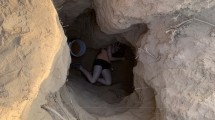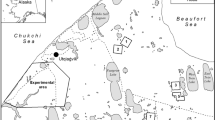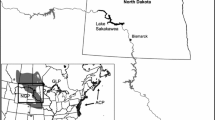Abstract
Oviposition site choice affects a host of offspring phenotypes and directly impacts maternal fitness. Recent evidence suggests that oviparous reptiles often select nest sites where the landscape has been altered by anthropogenic activity, whereas natural nest sites are less often used. We leverage a long-term study of snapping turtle (Chelydra serpentina) to identify natural nest sites and anthropogenic nest sites and to compare habitat variables among nest site types. Natural and anthropogenic nest sites did not differ in average canopy closure, distance to nearest water, substrate composition, or aspect. However, anthropogenic nest sites had less ground-level vegetation and greater soil brightness, and were 3.3 °C warmer than natural nests during incubation. We used the Schoolfield model of poikilotherm development to assess differences in development rate between natural and anthropogenic nests. Because of the difference in temperature, embryos in anthropogenic nests were predicted to have undergone nearly twice as much development as embryos in natural nests during incubation. We outline why the evolution of fast embryonic development rate cannot compensate indefinitely for the low temperature incubation regimes that become increasingly prevalent at northern range margins, thereby underlining why maternal nest site choice of relatively warm anthropogenic sites may help oviparous reptiles persist in thermally constrained environments. Future research should aim to quantify both the thermal benefits of anthropogenic nest sites, as well as associated fitness costs (e.g., increased adult mortality) to elucidate whether anthropogenic disturbance of the landscape can be an ecological trap or serve a net benefit to some reptiles in northern environments.





Similar content being viewed by others
References
Amarasekare P, Johnson C (2017) Evolution of thermal reaction norms in seasonally varying environments. Am Nat 189:E31–E45. https://doi.org/10.1086/690293
Andrews RM, Mathies T (2000) Natural history of reptilian development: constraints on the evolution of viviparity. Bioscience 50:227–238. https://doi.org/10.1641/0006-3568(2000)050%5b0227:NHORDC%5d2.3.CO;2
Angilletta MJ Jr (2009) Thermal adaptation: a theoretical and empirical synthesis. Oxford University Press, Oxford
Ardia D, Mullen KM, Peterson BG, Ulrich J (2016) ‘DEoptim’: differential evolution in ‘R’, version 2.2-4
Beaudry F, deMaynadier PG, Hunter ML Jr (2010) Nesting movements and the use of anthropogenic nesting sites by spotted turtles (Clemmys guttata) and Blanding’s turtles (Emydoidea blandingii). Herpetol Conserv Biol 5:1–8
Bernardo J (1996) The particular maternal effect of propagule size, especially egg size: patterns, models, quality of evidence and interpretations. Am Zool 36:216–236. https://doi.org/10.1093/icb/36.2.216
Bleakney S (1958a) A zoogeographic study of the amphibians and reptiles of eastern Canada. Natl Mus Can 155:1–119
Bleakney S (1958b) Postglacial dispersal of the turtle Chrysemys picta. Herpetologica 14:101–104
Bobyn ML, Brooks RJ (1994) Incubation conditions as potential factors limiting the northern distribution of snapping turtles, Chelydra serpentina. Can J Zool 72:28–37. https://doi.org/10.1139/z94-005
Booth DT, Burgess E, McCosker J, Lanyon JM (2004) The influence of incubation temperature on post-hatching fitness characteristics of turtles. Int Congr Ser 1275:226–233. https://doi.org/10.1016/j.ics.2004.08.057
Bowne DR, Cosentino BJ, Anderson LJ, Bloch CP, Cooke S, Crumrine PW, Dallas J, Doran A, Dosch JJ, Druckenbrod DL, Durtsche RD, Garneau D, Genet KS, Fredericksen TS, Kish PA, Kolozsvary MB, Kuserk FT, Londquist ES, Mankiewicz C, March JG, Muir TJ, Murray KG, Santulli MN, Sicignano FJ, Smallwood PD, Urban RA, Winnett-Murray K, Zimmermann CR (2018) Effects of urbanization on the population structure of freshwater turtles across the United States. Conserv Biol. https://doi.org/10.1111/cobi.13136
Brooks RJ (2007) Do reptiles in Canada have a future? An overview of the constraints on conserving Canadian snakes, turtles, and lizards. In: Seburn CNL, Bishop CA (eds) Ecology, conservation, and status of reptiles in canada. Herpetological Conservation Series Number Two. Society for the Study of Amphibians and Reptiles, Salt Lake City, pp 183–190
Brooks RJ, Galbraith DA, Nancekivell EG, Bishop CA (1988) Developing management guidelines for snapping turtles. In: Szaro RC, Severson KE, Patton DR (eds). Symposium on management of amphibians, reptiles, and small mammals in North America (July 19–21, 1988), USDA Forest Service General Technical Report RM–166. Flagstaff, pp 174–179
Brooks RJ, Brown GP, Galbraith DA (1991) Effects of a sudden increase in natural mortality of adults on a population of the common snapping turtle (Chelydra serpentina). Can J Zool 69:1314–1320. https://doi.org/10.1139/z91-185
Buhlmann KL, Osborn CP (2011) Use of an artificial nesting mound by wood turtles (Glyptemys insculpta): a tool for turtle conservation. Northeast Nat 18(3):315–334. https://doi.org/10.1656/045.018.0305
Bull JJ, Vogt RC (1979) Temperature-dependent sex determination in turtles. Science 206:1186–1188. https://doi.org/10.1126/science.505003
Congdon JD, Gibbons JW (1985) Egg components and reproductive characteristics of turtles: relationships to body size. Herpetologica 41:194–205
Congdon JD, Dunham AE, van Loben Sels RC (1993) Delayed sexual maturity and demographics of Blanding’s turtles (Emydoidea blandingii): implications for conservation and management of long-lived organisms. Conserv Biol 7:826–833. https://doi.org/10.1046/j.1523-1739.1993.740826.x
Congdon JD, Dunham AE, van Loben Sels RC (1994) Demographics of common snapping turtles (Chelydra serpentina): implications for conservation and management of long-lived organisms. Am Zool 34:397–408
de Solla SR, Gugelyk JA (2018) Oviposition and subsequent depredation of snapping turtle (Chelydra serpentina) nests in fresh asphalt. Can Field Nat 132(2):103–107. https://doi.org/10.22621/cfn.v132i2.2035
Edge CB, Rollinson N, Brooks RJ, Congdon JD, Iverson JB, Janzen FJ, Litzgus JD (2017) Phenotypic plasticity of nest timing in a post-glacial landscape: how do reptiles adapt to seasonal time constraints? Ecology 98:512–524. https://doi.org/10.1002/ecy.1665
Ernst CH, Lovich JE (2009) Turtles of the United States and Canada, 2nd edn. Johns Hopkins University Press, Baltimore
Ewert MA (1985) Embryology of turtles. In: Gans C, Maderson PFA, Billett F (eds) Biology of the reptilia (v 14). Wiley-Interscience, New York, pp 75–267
Ewert MA, Lang JW, Nelson CE (2005) Geographic variation in the pattern of temperature-dependent sex determination in the American snapping turtle (Chelydra serpentina). J Zool Lond 265:81–95. https://doi.org/10.1017/S0952836904006120
Gilchrist GW (1995) Specialists and generalists in changing environments. I. Fitness landscapes of thermal sensitivity. Am Nat 146:252–270
Hale R, Swearer SE (2016) Ecological traps: current evidence and future directions. Proc R Soc B 283:20152647. https://doi.org/10.1098/rspb.2015.2647
Haxton T (2000) Road mortality of snapping turtles, Chelydra serpentina, in central Ontario during their nesting period. Can Field Nat 114:106–110
Heppel SS (1998) Application of life-history theory and population model analysis to turtle conservation. Copeia 1998:367–375. https://doi.org/10.2307/1447430
Holman JA, Andrews KD (1994) North American quaternary cold-tolerant turtles: distributional adaptations and constraints. Boreas 23:44–52. https://doi.org/10.1111/j.1502-3885.1994.tb00585.x
Hughes EJ, Brooks RJ (2006) The good mother: does nest-site selection constitute parental investment in turtles? Can J Zool 84:1545–1554. https://doi.org/10.1139/z06-148
Janzen FJ (1994) Vegetational cover predicts the sex-ratio of hatchling turtles in natural nests. Ecology 75:1593–1599. https://doi.org/10.2307/1939620
Janzen FJ, Morjan CL (2001) Repeatability of microenvironment-specific nesting behaviour in a turtle with environmental sex determination. Anim Behav 62:73–82. https://doi.org/10.1006/anbe.2000.1732
Joyal LA, McCollough M, Hunter ML Jr (2001) Landscape ecology approaches to wetland species conservation: a case study of two turtle species in southern Maine. Cons Biol 15:1755–1762. https://doi.org/10.1046/j.1523-1739.2001.98574.x
Juliana JR, Bowden RM, Janzen FJ (2004) The impact of behavioral and physiological maternal effects on offspring sex ratio in the common snapping turtle, Chelydra serpentina. Behav Ecol Sociobiol 56:270–278. https://doi.org/10.1007/s00265-004-0772-y
Kearney M, Porter WP (2004) Mapping the fundamental niche: physiology, climate, and the distribution of a nocturnal lizard. Ecology 85:3119–3131. https://doi.org/10.1890/03-0820
Keevil MG, Brooks RJ, Litzgus JD (2018) Post-catastrophe patterns of abundance and survival reveal no evidence of population recovery in a long-lived animal. Ecosphere 9(9):e02396. https://doi.org/10.1002/ecs2.2396
Kolbe JJ, Janzen FJ (2002) Impact of nest-site selection on nest success and nest temperature in natural and disturbed habitats. Ecology 83:269–281. https://doi.org/10.1890/0012-9658(2002)083%5b0269:IONSSO%5d2.0.CO;2
Lapointe J (2018) Chelydra serpentina (snapping turtle) nesting range expansion. Herpetol Rev 49:316–317
Lesbarrères D, Ashpole SL, Bishop CA, Blouin-Demers G, Brooks RJ, Echaubard P, Govindarajulu P, Green DM, Hecnar SJ, Herman T, Houlahan J, Litzgus JD, Mazerolle MJ, Paszkowski CA, Rutherford P, Schock DM, Storey KB, Lougheed SC (2014) Conservation of herpetofauna in northern landscapes: threats and challenges from a Canadian perspective. Biol Cons 170:48–55. https://doi.org/10.1016/j.biocon.2013.12.030
Loncke DJ, Obbard ME (1977) Tag success, dimensions, clutch size and nesting site fidelity for the snapping turtle, Chelydra serpentina (Reptilia, Testudines, Chelydridae) in Algonquin Park, Ontario, Canada. J Herpetol 11:243–244
Martin TL, Huey RB (2008) Why suboptimal is optimal: jensen’s inequality and ectotherm thermal preferences. Am Nat 171:E102–E118. https://doi.org/10.1086/527502
Mesquita DO, Costa GC, Colli GR, Costa TB, Shepard DB, Vitt LJ, Pianka ER (2016) Life-history patterns of lizards of the world. Am Nat 187:689–705. https://doi.org/10.1086/686055
Midwood JD, Cairns NA, Stoot LJ, Cooke SJ, Blouin-Demers G (2015) Bycatch mortality can cause extirpation in four freshwater turtle species. Aquat Cons Mar Freshw Ecosyst 25:71–80. https://doi.org/10.1002/aqc.2475
Mitchell TS, Warner DA, Janzen FJ (2013) Phenotypic and fitness consequences of maternal nest-site choice across multiple early life stages. Ecology 94:336–345. https://doi.org/10.1890/12-0343.1
Obbard ME, Brooks RJ (1980) Nesting migrations of the snapping turtle (Chelydra serpentina). Herpetologica 36:158–162
Obbard ME, Brooks RJ (1981) Fate of overwintered clutches of the common snapping turtle (Chelydra serpentina) in Algonquin Park, Ontario. Can Field Nat 95:350–352
Paterson JE, Steinberg BD, Litzgus JD (2013) Not just any old pile of dirt: evaluating the use of artificial nesting mounds as conservation tools for freshwater turtles. Oryx 47:607–615. https://doi.org/10.1017/S0030605312000877
Price KV, Storn RM, Lampinen JA (2006) Differential evolution—a practical approach to global optimization. Springer, New York
Quinn DP, Kaylor SM, Norton TM, Buhlmann KA (2015) Nesting mounds with protective boxes and an electric wire as tools to mitigate diamond-backed terrapin (Malaclemmys terrapin) nest predation. Herpetol Cons Biol 10(3):969–977
R Core Team (2018) R: a language and environment for statistical computing. R Foundation for Statistical Computing, Vienna, Austria. R version 3.4.4 and 3.5.0
Refsnider JM, Janzen FJ (2010) Putting eggs in one basket: ecological and evolutionary hypotheses for variation in oviposition-site choice. Annu Rev Ecol Evol Syst 41:39–57. https://doi.org/10.1146/annurev-ecolsys-102209-144712
Richter-Boix A, Katzenberger M, Duarte H, Quintela M, Tejedo M, Laurila A (2015) Local divergence of thermal reaction norms among amphibian populations is affected by pond temperature variation. Evol 69:2210–2226. https://doi.org/10.1111/evo.12711
Riley JR, Litzgus JD (2013) Evaluation of predator-exclusion cages used in turtle conservation: cost analysis and effects on nest environment and proxies of hatchling fitness. Wildl Res 40:499–511. https://doi.org/10.1071/WR13090
Riley JR, Freedberg S, Litzgus JD (2014) Incubation temperature in the wild influences hatchling phenotype of two freshwater turtle species. Evol Ecol Res 16:397–416
Rollinson N, Hutchings JA (2013) Environmental quality predicts optimal egg size in the wild. Am Nat 182:76–90. https://doi.org/10.1086/670648
Rollinson N, Holt SM, Massey MD, Holt RC, Nancekivell EG, Brooks RJ (2018) A new method of estimating thermal performance of embryonic development rate yields accurate prediction of embryonic age in wild reptile nests. J Therm Biol 74:187–194. https://doi.org/10.1016/j.jtherbio.2018.03.008
Schoolfield RM, Sharpe PJH, Magnuson CE (1981) Non-linear regression of biological temperature-dependent rate models based on absolute reaction rate theory. J Theor Biol 88:719–731. https://doi.org/10.1016/0022-5193(81)90246-0
Telemeco RS, Gangloff EJ, Cordero GA, Mitchell TS, Bodensteiner BL, Holden KG, Mitchell SM, Polich RL, Janzen FJ (2016) Reptile embryos lack the opportunity to thermoregulate by moving within the egg. Am Nat 188:E13. https://doi.org/10.1086/686628
Thompson MM, Coe BH, Congdon JD, Stauffer DF, Hopkins WA (2017) Nesting ecology and habitat use of Chelydra serpentina in an area modified by agricultural and industrial activity. Herpetol Cons Biol 12:292–306
Valenzuela N (2001) Constant, shift, and natural temperature effects on sex determination in Podocnemis expansa turtles. Ecology 82:3010–3024. https://doi.org/10.1890/00129658(2001)082%5b3010:CSANTE%5d2.0.CO;2
Vickers MJ, Aubret F, Coulon A (2017) Using GAMM to examine inter-individual heterogeneity in thermal performance curves for Natrix natrix indicates bet hedging strategy by mothers. J Therm Biol 63:16–23. https://doi.org/10.1016/j.jtherbio.2016.11.003
Wilson DS (1998) Nest-site selection: microhabitat variation and its effects on the survival of turtle embryos. Ecology 79:1884–1892. https://doi.org/10.1890/0012-9658(1998)079%5b1884:NSSMVA%5d2.0.CO;2
Yntema CL (1976) Effects of incubation temperatures on sexual differentiation in the turtle, Chelydra serpentina. J Morph 150:453–462. https://doi.org/10.1002/jmor.1051500212
Acknowledgements
We would like to thank Jacqueline D. Litzgus and Ronald J. Brooks for collaborative use of long-term study site and system; Algonquin Park/Ontario Parks for permission to conduct research; and Algonquin Wildlife Research Station for field accommodation; Nicole Brunet, Taylor Wynia, and Steven Kell for assistance in the field; Lin Schwarzkopf and one anonymous reviewer for helpful comments that improved this paper. All applicable institutional and national guidelines for the care and use of animals were followed.
Funding
We acknowledge and thank the University of Toronto Faculty of Arts and Science Research Excursion Program, an NSERC Discovery Grant (# 2016-06469) to NR, a postdoctoral fellowship from the University of Toronto Department of Ecology and Evolutionary Biology to MAG, and Algonquin Park/Ontario Parks for funding that supported this research.
Author information
Authors and Affiliations
Contributions
PDM conceived and designed the experiment. EAF and PDM conducted fieldwork. EAF, MAG, and NR analyzed the data. EAF, PDM, MAG, and NR wrote the manuscript.
Corresponding author
Ethics declarations
Conflict of interest
All authors declare no conflict of interest.
Additional information
Communicated by Lin Schwarzkopf.
Our findings of a thermal trade-off between anthropogenic and natural nests explains one of the most pervasive threats to turtle populations globally: road mortality and roads as an ecological trap.
Electronic supplementary material
Below is the link to the electronic supplementary material.
Rights and permissions
About this article
Cite this article
Francis, E.A., Moldowan, P.D., Greischar, M.A. et al. Anthropogenic nest sites provide warmer incubation environments than natural nest sites in a population of oviparous reptiles near their northern range limit. Oecologia 190, 511–522 (2019). https://doi.org/10.1007/s00442-019-04383-3
Received:
Accepted:
Published:
Issue Date:
DOI: https://doi.org/10.1007/s00442-019-04383-3




